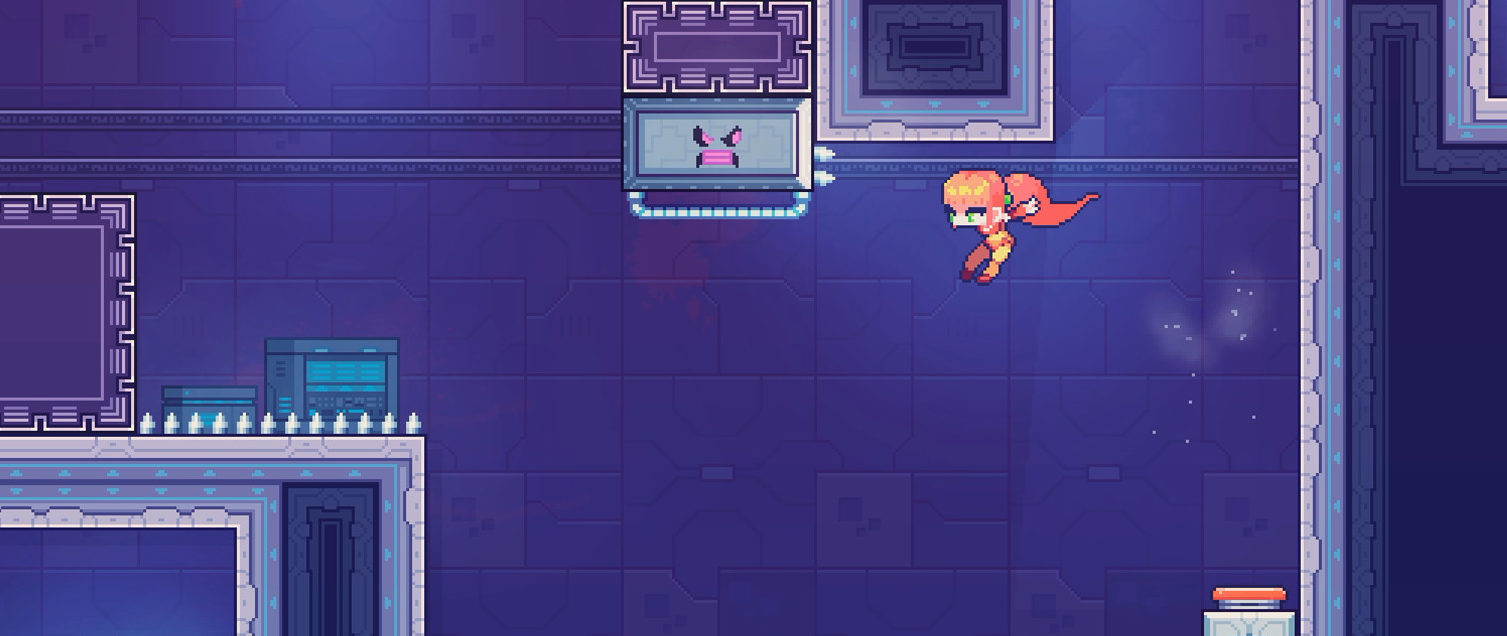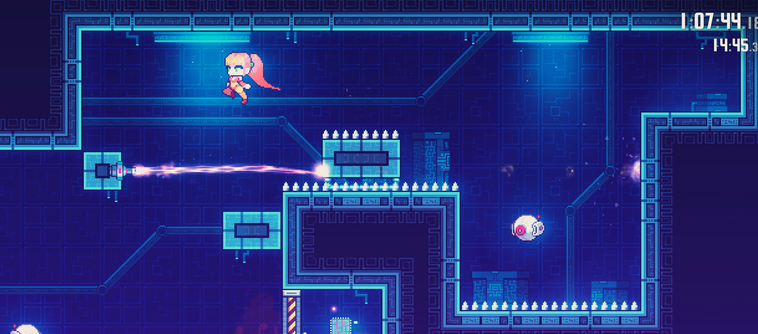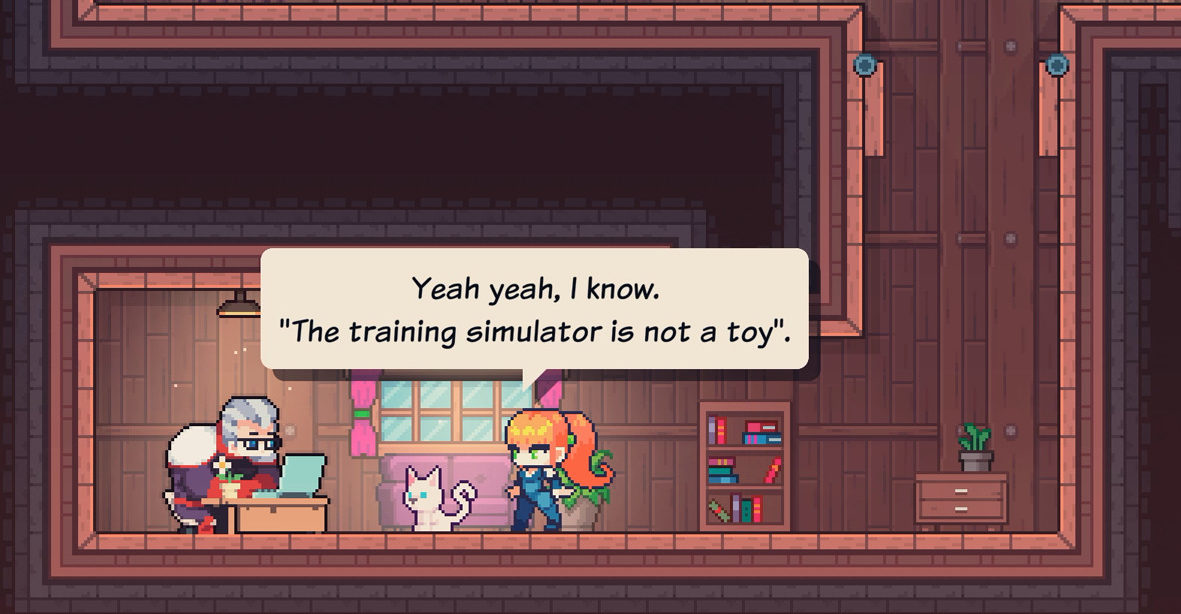Platforms:
PC,
Released:
June 3, 2021
Publisher:
Bonus Stage Publishing
Developer:
Games From Earth
Sunblaze is a handcrafted, precision platformer that boasts an ability to “keep you dying for hours and hours.” It’s a good game and one I happily recommend. However, I’d be lying if I said I didn’t have a rough time playing through this one. If you’re not into difficult games, this might not be the title for you.
Sunblaze is inspired by Celeste, and as a fan, I saw the connection between the two instantly. It is a somewhat balanced comparison, with Sunblaze falling a little shy of the lofty heights reached by the 2018 precision platformer. I personally love a good marriage of story and gameplay, something Celeste excels at, whereas Sunblaze tilts more towards the challenging gameplay side of the spectrum. It’s definitely full of controller clutching tension, though it lacks the comprehensiveness of Celeste’s gameplay mods.
Pain and Simple: The Basics
Sunblaze, in many ways, is a very straightforward title. If you watch the trailer above, truly you will understand a lot of what the game is working with. This is a precision platformer with some cool ideas. You can jump, you can dash, but above all else, you can just get physically obliterated so so many times.
“…I died 6287 times, over a 13-hour campaign. That’s an average death every 7 seconds.”
There is some variety in how you messily exit this plane of existence. Each chapter draws in some new ideas, which match up well with the level’s themes. Even in the first few sections, where all personality has been sterilised, there’s still a sense of this being the “tutorial” world. Subsequent sections get a bit wilder. A “mine” themed level, for instance, introduces area-of-effect explosives.
The simplicity of design is echoed in the presentation. Scenes morph from one room to the next. Obstacles have, for the most part, clear demarcations between safety and death. Even so, it’s often surprising how narrow the margins are. Obstacles can and will be triggered at the slightest provocation. The sound design also plays quite a big role in navigating the levels. Each obstacle has audio that can clue you into when these triggers get pulled or help you follow the “rhythm” of timed obstacles. It can really sync you up to the world. This is the kind of game with so much going on, that at times the best thing you can do is follow the rhythm and work on instinct.

Super Smear-o: Death and Unfairness
It’s obviously no accident that Sunblaze is a bloodbath. Upon death, Josie is reduced to a bloody smear, the death count clicks over and then you’re dropped back at the start of the level. The pause menu has your game time and death states. I can tell you that, on the regular mode, I died 6287 times over a 13-hour campaign. That’s an average death every 7 seconds. I have no intention, however, to decry this game as being “too hard”. Difficulty is of course based on the taste of the player. Generally speaking, I enjoy a good challenge in certain genres. However, I start to draw lines when deaths feel a little outside of the player’s control.
“The slim chances the game gives you to successfully defeat a room ensure that each win feels like a truly euphoric achievement.”
It’s worth considering that for as simple as the genre may seem, platformers are hard to pull off. So much work in programming and design comes down to polish and user-friendliness. All things considered, Sunblaze does an admirable job. It hits a reasonably polished standard for the genre. However, in places, it doesn’t quite hit the mark. The jump, for example, falls a little short.
The jumps and double jumps are barely high enough to reach platforms. You can hit these marks, though it can be unreliable. You may clamber onto a platform, you may not. Some obstacles, such as the explosives, require jumping onto and off of the object in quick succession. These kinds of intersections and circumstances tend to compound and domino. It’s a system that makes the margin for error exceedingly narrow. It reflects the central tug of war that defines my personal enjoyment of games with this kind of challenging streak. The slim chances the game gives you to successfully defeat a room ensure that each win feels like a truly euphoric achievement. However, those slim chances and dopamine hits are earned through the labour of dozens of gory failures that preceded.
In Sunblaze, as with many games, feedback is essential. To Sunblaze’s credit, it does a good job. Let’s consider the boost function and its associated visual character feedback. If Josie is wearing yellow, you can boost, but if she’s all dressed in blue, the boost is tapped out. It is a frankly brilliant idea. In a chaotic genre like a precision platformer, visibility of information is imperative. At any given moment, the player is staring at the character model. Coupling the visual indicator with the central point of focus is nothing short of genius.
There’s just one little gap on the feedback front which is the double jump. Both boost and double jump can only be used once before touching down or ramming certain objects. I am glad boost gets the colour change, but it does make the lack of feedback for double jump a little frustrating. Any given run is a flurry of jumps and boosts and ledge-grabs and such. It’s hard to remember exactly what resources you have at your disposal and it can be hard to track when resources replenish if there’s no indicator. Many times the lack of double jump feedback was exacerbated by how often I worried about getting “up there” rather than “over there”. It wasn’t always a major issue, but there were times I would realise I had no double jump at a rather inopportune moment.

Powering up: Sunblaze, Difficulty Modulation, and Zen Mode
The difficulty in Sunblaze isn’t just a solid brick wall. Interestingly enough, the difficulty curve does seem to oscillate a little across consecutive levels. After finally clawing through the end of a ferocious room, I sometimes breezed the following room in a few tries. Don’t let it be said that this is a bad thing. In truth, the modulation did make it feel more doable and less punishing. As with most challenging traversal games like this, when it’s going well it feels amazing, and when you’re doing bad it’s infuriating. In truth, while I wish it were less punishing, it still took a long time before I dipped into the difficulty options.
There are some accessibility modifications available in Sunblaze. There aren’t options such as colourblind modes or the like, but there are mods to bring down the gameplay challenge. It’d be nice to see the game being accessible in ways other than just difficulty, especially if you’re using that term, but I digress.
“The ability to modulate the type and severity of certain challenges really helps you dial in an experience.“
I appreciate the inclusion of difficulty options. Difficulty options in my mind need to be in more games. The ability to modulate the type and severity of certain challenges really helps you dial in an experience. Sunblaze would occasionally bounce past my threshold, so I decided rather than smashing through this wall headfirst, I’d manipulate the options a little. Sunblaze’s difficulty options lie on a spectrum of impact on the gameplay. The lower-end changes are, for example, higher jumps and double jumps. Of course, this isn’t always helpful, given some levels have low ceilings. On the other end of the spectrum, some options feel like they overcorrect. Invincibility, infinite double jump (i.e. “The Kirby”), and infinite dash all feel like they trivialise a lot of the rooms.
Unfortunately, I didn’t get as much utility from the difficulty options as I would have liked. I spent most of the game with them off. The exception was the last two or three chapters where higher jumps essentially fixed my previous issues. What I really wanted though was more finite control. Often, it felt like lowering the difficulty would swing the needle a bit too far in the other direction, making things too easy. This is most notable in running the easy version of Sunblaze in “Zen Mode”.
If you really want to, you can just play through the story with Zen Mode. The idea is it lets you play the story with only a few levels, most of which are rather easy. How easy? Well, remember how it took 13 hours to clear the regular campaign? I finished Zen Mode in 36 minutes. Hell, I could easily have cleared that with 0 deaths.
Zen Mode’s difficulty has two main side effects on the campaign. Firstly, the story, as we shall discuss, isn’t terribly exciting. It’s definitely not awful but it’s certainly not a solid enough foundation for an entire game mode. In Sunblaze, the gameplay will be and should be the main focus point. The other issue is that difficulty is so core to the game’s design, removing it entirely doesn’t play to Sunblaze’s strength. As much as the game was arduous, you can at least sail on the euphoria of achievement from rolling credits. However, chopping out the challenge undermines your ability to get the whole experience.

Powersnuff Girls: Is Sunblaze a Saturday Morning Cartoon?
Games, especially indie ones, tend to focus on either gameplay or story. As such, when the mechanics are front and centre, the story is more of a background. It is essentially your incentive. The plot here focuses on Josie (aka Sunblaze), the daughter of a superhero. The day has finally come for her to train to become a superhero herself. The training takes place on a simulated training course, one that twists and warps geography to bring in all manner of obstacles. Soon it becomes clear that there is a glitch in the system, so Josie must fight her way out.
The plot is a bit lacklustre, perhaps to be expected. In a game like this, the story merely acts as a background upon which the gameplay is staged. It simply provides a thin veneer of context for a system that turns young hopeful superheroines into bloody smears. That’s ok, though it does undermine my veracity to keep pushing through frustration in the regular mode and question the necessity of Zen Mode. I’m generally more positive about the dialogue, though it is not without any complications.
Speech Troubles: Overloading on Dialogue Cheese
There’s a nice back and forth between Josie and her father. The daughter will be sarcastic and dry, full of a rebellious streak. The father will be a bit wary out of love, but overwhelmingly dorky. So much of the dialogue that plays out is sweet and a little cheesy, but some of the cheese feels forced. The dad jokes are relentless. At one point Josie says “I’m getting the hang of this” to which the dad replies “Hi getting the hang of this, I’m dad”. I suppose comedy is subjective so if you like this kind of humour, then I’m very sorry to all your close relatives that have to hear your attempts to make jokes.

There’s this feeling that a lot of this narrative is borne of clichés for this reason. Another character is an AI that presents itself as a unicorn. Why? Well, the AI didn’t want to freak out Josie, and she liked unicorns… when she was five. This is what the blending of “I am a good version of sentience, so I look like a cute thing” and “embarrassing a teenager with aspects of childhood” tropes looks like. Once again, if you have a sense of humour that allows you to laugh at this, more power to you. Some jokes do land. For example, Josie’s cat is named Ms. Pryde, a reference I did enjoy.
All this plays into really the overall feeling that is being brought to the game. It’s banking on a kind of dumb fun nostalgia from its audience. A kind of Saturday morning cartoon feel. You could swap the scripts of Sunblaze and the Powerpuff Girls, and it wouldn’t feel off-key. In that way, I suppose the comedy may be justified. It is worth mentioning that I do say nostalgia with purpose. This is to a certain extent doled out in the usual fashion of pixel graphics. It also makes sense in this lens because it doesn’t feel like it’s really designed for kids. On one hand, there is the aforementioned difficulty. I can’t really see this being a game kids would be into, though perhaps that’s where Zen Mode comes in. The other issue is if it’s even appropriate for kids. It took a while to realise that Josie is literally only wearing a bikini. Also, once again, she dies a lot. She gets crushed, impaled, electrocuted until her body explodes, blown up with TNT, or if you’re lucky, she just falls into the abyss. It’s hard to see this marketed to a younger audience. So it seems more likely this is aimed at an older nostalgic audience. Albeit one willing to overlook the cheesy clichés of the story.
7
Good
Positive:
- Strong gameplay mechanics
- Great deal of challenge but doesn't feel insurmountable
- Presentation is simple and direct in giving a lot of player information
Negative:
- Difficulty modulation isn't granular enough to tailor the experience
- Some gaps in player feedback, and platformer user-friendliness is a bit grating
- Lacklustre story
Sunblaze earns its place as a brutal but mostly fair challenge. It is exciting and fresh in its gameplay in a lot of ways that people should pay attention to. The difficulty will be satisfying for some but frustrating for others. Whilst a lacking story holds it back, clever design mechanics propel it forward. With all that said, when you’re dying every seven seconds, it’s easy for any shining praise to start to dull.





